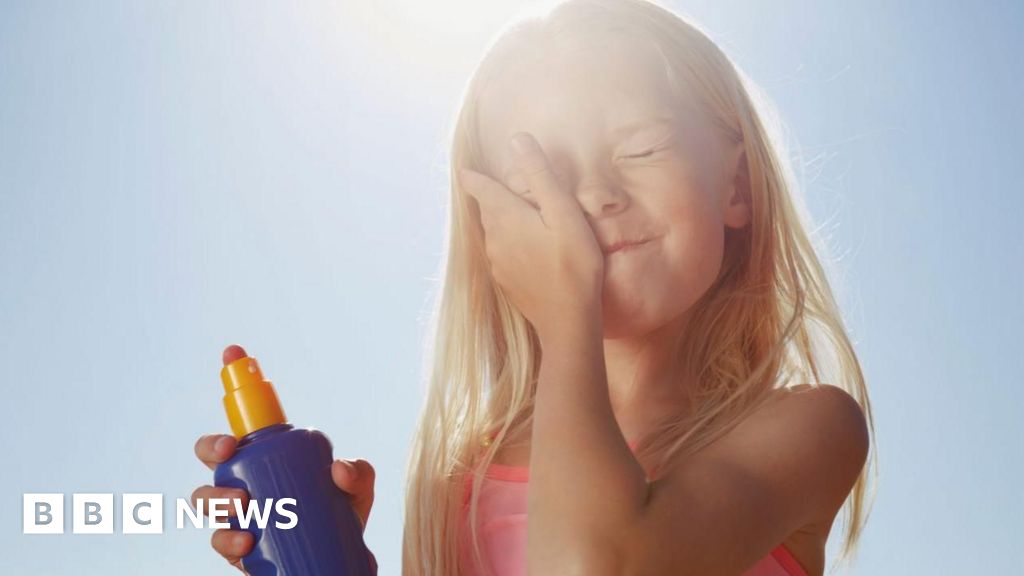Children as young as five are being taught how to check UV levels and apply sunscreen, as part of a new pilot aimed at reducing future skin cancer cases. The initiative, currently being trialled in primary schools across Kent, is planned to be introduced into Personal, Social, Health and Economic (PSHE) lessons nationwide from 2026. Melanoma, the most serious form of skin cancer, is linked to UV exposure - and experts say sunburn in childhood significantly increases the risk later in life. In 2021, around 18,300 people were diagnosed with melanoma in the UK, according to Cancer Research. That figure is projected to rise to 21,300 by 2026, the charity says. Michelle Baker, from the charity Melanoma Fund, which is behind the education project, said changing children's habits early is key. "People think melanoma is an older person's disease," she says, "but it's often seeded in childhood." She says the project aims to "grow skin cancer out of the next generation". Giving children a sense of control and responsibility for their sun protection is central to this. "We're saying this is your superpower," she adds. At Platt Primary school in Maidstone, pupils are learning to read UV indexes, apply sunscreen properly, and understand when they need protection. Headteacher Emma Smith said the pupils have been "really receptive". "If we educate them early, they're more likely to keep that knowledge as they get older - especially when social media starts to influence their choices." The childhood sun safety drive comes as Cancer Research UKsays the rise in melanoma casesamong adults is a particular cause for concern. A recent study from the charity found that cancer deathscost the UK economy £10.3bn a year, more than any other health condition – underlining the importance of preventative measures. Consultant dermatologist Dr Katie Lacy says that educating children about how to look after their skin is key to reducing melanoma rates. Research shows that nine out of 10 cases are caused by UV exposure from the sun and sunbeds. Getting sunburnt regularly increases the chances of skin cancer. Dr Lacy stresses there is no such thing as a "safe tan", explaining that tanning is a response to skin damage. "Most melanomas don't come from existing moles - so if you notice something new, get it checked," she adds. She also highlights the growing role of AI in screening suspicious moles within the NHS - which could help streamline referrals to specialist services. The ABCDE checklist can help identify if a mole is abnormal: A - asymmetrical (does the mole have an uneven shape?) B - border (are the edges blurry or jagged?) C - colour (is it an uneven colour with different shades and tones?) D - diameter (is the mole bigger than your other ones?) E - evolving (is it changing, such as starting to itch, bleed or become crusty?) Source: Cancer Research UK For Kara Leece, diagnosed with melanoma at 29, the message is personal. "If I'd had that education at primary school, I think I could've prevented it," she told BBC News. "Now I have a scar that reminds me of what I've been through. When children ask about it, I tell them my story - because I don't want this to happen to anyone else." Source: Cancer Research UK
School sun safety lessons trialled to tackle skin cancer
TruthLens AI Suggested Headline:
"Pilot Program Teaches Sun Safety in Schools to Combat Melanoma Risk"
TruthLens AI Summary
A new pilot program is being implemented in primary schools across Kent, where children as young as five are being educated on sun safety to combat rising skin cancer rates. This initiative focuses on teaching children how to check UV levels and apply sunscreen effectively. The program is designed to be integrated into the Personal, Social, Health and Economic (PSHE) curriculum nationwide by 2026. Experts highlight the importance of addressing sunburn in childhood, as it significantly increases the risk of developing melanoma, the most severe form of skin cancer, later in life. In the UK, melanoma diagnoses are projected to rise from approximately 18,300 in 2021 to 21,300 by 2026, according to Cancer Research UK. Michelle Baker from the Melanoma Fund emphasizes the necessity of changing children's habits early, stating that melanoma is often seeded in childhood, and empowering children with knowledge about sun protection is crucial for their long-term health.
At Platt Primary School in Maidstone, students are actively learning to interpret UV indexes and understand when they need sun protection. Headteacher Emma Smith noted that the students have been very receptive to the lessons, which could instill lasting knowledge about sun safety as they grow older. The increasing rates of melanoma among adults are alarming, with cancer deaths costing the UK economy £10.3 billion annually, underscoring the importance of preventive education. Consultant dermatologist Dr. Katie Lacy stresses that nine out of ten melanoma cases are linked to UV exposure, and frequent sunburn raises the risk of skin cancer. She also warns that there is no such thing as a safe tan and encourages vigilance in monitoring moles for changes. Kara Leece, a melanoma survivor, shared her personal experience, expressing that early education on sun safety could have potentially prevented her diagnosis. She now uses her story to educate children about the importance of sun safety, hoping to prevent similar experiences for others in the future.
TruthLens AI Analysis
You need to be a member to generate the AI analysis for this article.
Log In to Generate AnalysisNot a member yet? Register for free.
